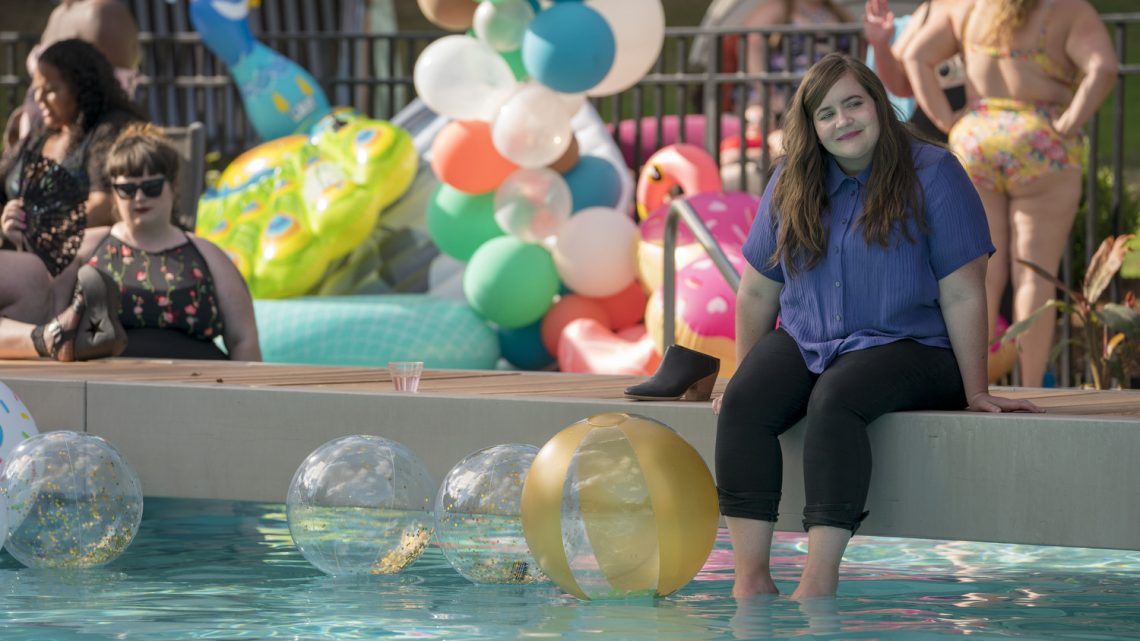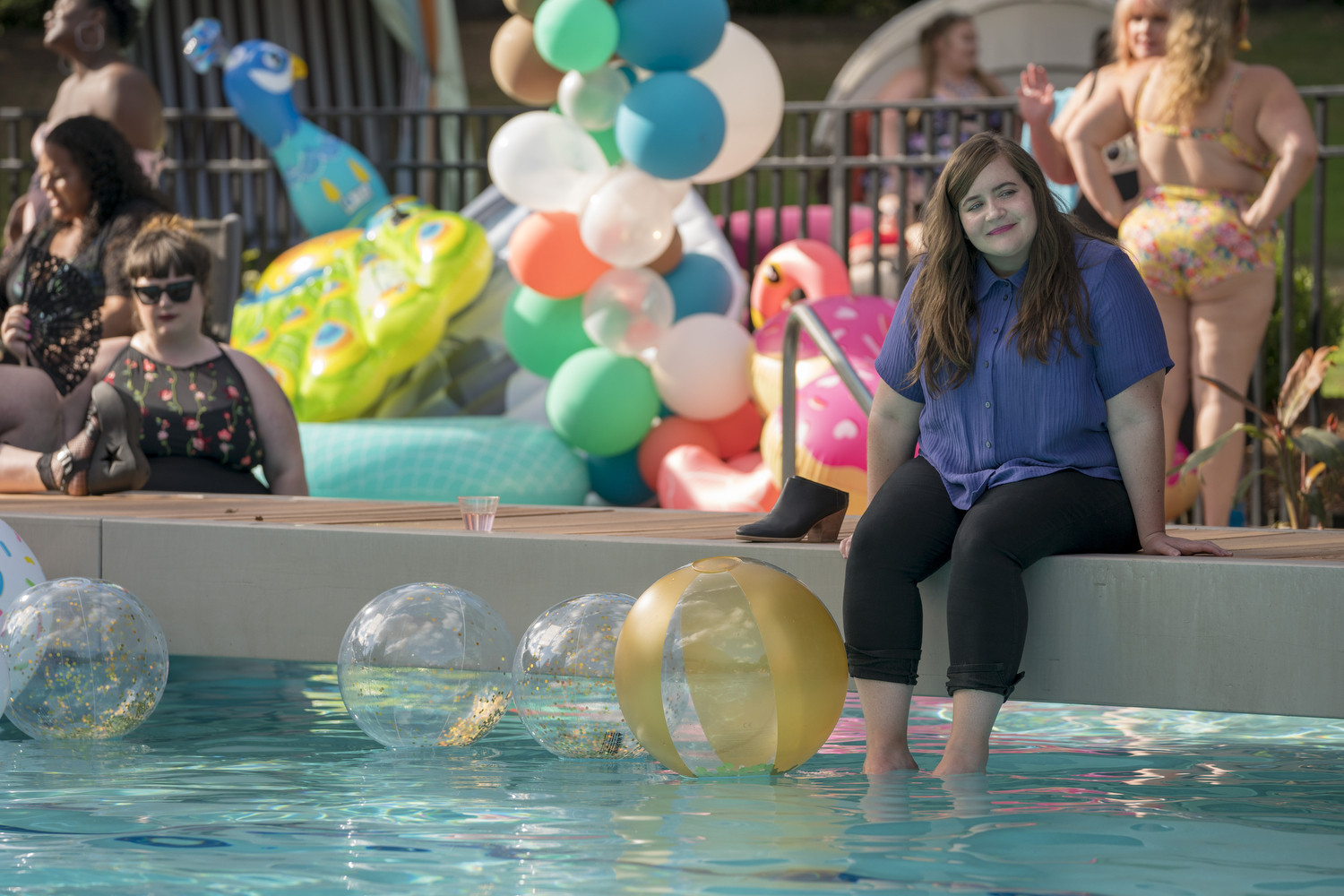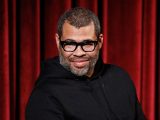
‘Shrill’ Is the Mona Lisa of Body Positive Television
March 22, 2019Within the first five minutes of Shrill, Annie Easton (Aidy Bryant) pauses while getting dressed and kneels down to stretch out her sweater over her knees. I immediately yelped. My tall, thin best friend didn’t understand what she was doing, at first. “Is it a self-esteem thing?” she asked. “Is she… gathering herself?” See, when you’re wearing plus-size clothing, a lot of it isn’t cut quite right for your body, so if you have a bigger tum, sometimes shirts that run too narrow need to get hit with what I like to call “the Ol’ Knee Stretcher.” I’d never seen my experience on screen portrayed sans explanation. Shrill is what every piece of Body Positive Media should be: made by us, for us, but accessible for everyone who wants to come along on the ride too.
The series' six-episode first season, streaming on Hulu, is based on Lindy West’s New York Times bestselling essay collection of the same name. West, Aidy Bryant, and showrunner Alexandra Rushfield, serve as co-creators. The writers room has more than one plus sized creator and it shows. Obviously, there’s West, who is also known for her biting essays and face-forward feminism on Jezebel and The New York Times among other publications, as well as Samantha Irby, author of the hilarious essay collections Meaty and We Are Never Meeting In Real Life. Bryant, now a seven-year running cast member on SNL, is a pitch perfect choice to play Annie, a fat woman in her 20s navigating life and trying to find herself within the alt-weekly she works for, her friendships, and her relationships with her parents and the kind of terrible dude she's seeing. In short, she’s a city-dwelling straight white woman in her twenties. She’s just also fat.
There’s been a wave of body-positivity-lite media recently, like the shallow and unsatisfying I Feel Pretty, which conflated insecurity with marginalization. Not long after, Netflix released the inherently fatphobic Insatiable, which included a scene where a fat girl fights a homeless man for a sandwich and starred a straight-sized actress in a fat suit. (Just hire fat actors. Please.) These shows completely miss the point. At its core, body positivity is a feminist political movement that centers some of the most marginalized—fat people, very fat people, people of color, people marginalized by gender, disabled people—and works for social and political change to make the world a safer place for bodies of all kinds to live in.
One of the show’s greatest successes as a comedy is its understanding of Actually Good Fat Jokes—jokes for fat people rather than at our expense. The show expertly satirizes the communal experience of living in a body that others treat like shit. It’s a long needed reclamation, because prejudice against fat people has so long taken away actually good fat jokes.
I spoke to Irby, over the phone, about this. When it comes to the diet food, branded “Thin Menu,” that Annie eats at the behest and purchase of her mom, she says, “That was my love letter to all my sisters in the struggle. I see you eat that one Lean Cuisine enchilada that looks like dog vomit; I’ve eaten it a million times. It’s disgusting.” Indeed, this “thin menu” is all too familiar to any fat person who has been trapped in a terrible prepared-food-diet program. “We have all eaten that food whether we wanted to or not...that to me was, like, the wink, I see you,” Irby said. “This is for our people. Those of you who get it will really fucking get it.”
Body positivity isn’t about feeling pretty or learning that “it’s what’s inside that counts.” It’s about systemic prejudice. It’s about dismantling the kind of ugly, deep set cultural biases that lead fat women to face a wage ceiling because people don’t want to hire or promote us, that leaves fat people without proper medical care or attention, and that abandons us without any kind of legal protection against discrimination based on our size and appearance. It’s not about learning to love our own personality and the content of our character instead of bemoaning our flesh; it’s about surviving and ferociously, defiantly thriving in a world that refuses to see us as anything but a “before picture.”
This is why we say the word “fat;” to underscore that we are striving for a world where it’s simply a descriptor, not something to be demeaned or embarrassed about. I’m fat, you’re short, they’ve got bangs—these are all simple physical descriptions. It’s also why many activists prefer the terms “fat positivity” or “fat liberation,” instead of the watered-down “body positivity.” Yes, all bodies are good bodies, but let’s be real about which bodies society really hates.
Luckily, the recent profitability of surface-level body positivity and corresponding content boom has allowed a few true gems to shine among the costume jewelry. The joyful Dumplin’ on Netflix, based on Julie Murphy’s book, shows the kind of rebellious, chubby teenage girl I never saw on screen as a protagonist. Dietland on AMC forced the hateful, tiny moments of despair that come from denigration and ridicule in your face over and over. While I found it not quite uplifting, it was still more honest and raw about the fat experience. These shows walked so Shrill could run. Shrill is the chubby Mona Lisa of the "Fatnaissance." Bryant’s portrayal of Annie is fully-rounded and realized. She’s not your fat best friend or a one-note punchline—instead she’s afforded space to learn her lessons repeatedly, to have the kind of growth trajectory that a protagonist deserves but fat characters are so often denied.
And this kind of perspective, where fat viewers finally get to be part of the in-group, explains why the rest of the show is so good. In the fourth episode of the show, “Pool,” Annie, wearing jeans and a shirt buttoned up to her neck, walks into a Fat Babe Pool Party with Fran, who’s confidently wearing her bathing suit. Annie is there to write about the party for the alt-weekly, but it’s really just an excuse for her to nervously walk through the door. Her entrance is unlike any moment I’ve seen of a fat girl insecure at a pool party on screen before: instead of feeling nervous around all the thin girls, Annie feels nervous because she’s not in the same place in her journey as other fat women walking by in string bikinis.
“We all are at different places on the path,” Irby said. “There’s a universe in which Annie would never even consider going to a party like that because she’s a little buttoned-up, repressed, listening to her mom’s diet talk her whole life. Just to see all the different shades of where you could be in your journey with yourself was really important, too, and I feel like we captured what a lot of people feel in just those few minutes.”

By the end, Annie finally jumps in the pool and swims through the clear blue water, kicking her jiggling legs and twisting joyfully around the thighs and stomachs and flesh of other fat women.
Irby, who wrote the episode, felt the same way when she flew to Portland to watch it be shot. “Lindy and I walked into the ballroom to see the extras and there are like 16 women in there who were really just all sizes," she said. "Like for real all sizes, and there were like so many swimsuit options, they had a makeup team and a hair team, there were women in wheelchairs and a woman who had just undergone chemo. And there were women of all ages, which is another thing. Like can I see a 50-year-old woman? Can I see a 60-year-old woman in a bikini on television in 2019? I would really love to. We both started to cry because I was like, they’re really doing it. This is like a fucking dream come true.”
Shrill tackles the bullshit “wellness and diet culture” head-on, from the very first episode. I, too, have been aggressively courted for an exercise class—once a woman in a Kohl’s handed me a card wordlessly, put her hand on my stomach, and walked away. I walked around feeling light-headed for an hour, reeling from the one-two punch of having a stranger touch me and seeing the card read “Yoga And Fitness For Expecting Mothers.” I was not pregnant. The woman in the pilot episode, who calls Annie a “fat bitch” for not accepting her patronizing help has a similar sneering vibe. “If you ask a thin person, they’d be like, 'no, that doesn’t ever happen,'” Irby explained. If you ask a fat person, they’ll say, 'oh a few times this morning people have asked me if I’ve thought about going paleo.'”
The show also dives into the kinds of abuse that fat people face in the workplace. In the second episode, Annie confronts a troll (played with incredible smarminess by SNL’s Beck Bennett), who has been leaving nasty comments on her articles felt all too real to me. Some of these comments are taken directly from West’s conversation with one of her real-life trolls, on a breath-taking episode of This American Life. On screen and in real life, the man who hurled terrible, disturbing insults admits to hating her because he’s resentful that she seems so confident, and so sure of her words, while also being fat.
But the show nails details even more personal and small and subliminal than that—like the tension between physical enjoyment and painful self-awareness. These moments are ultimately the most important. After Annie has a positive sexual experience with a guy she likes, she goes to the kitchen to eat the dinner she missed. Alone, she finally enjoys her spaghetti freely and messily. That comfort found in privacy felt so familiar—eating when nobody can watch you or enjoying a hotel pool late at night when nobody is around to judge. The moment when Annie sees a fashionable, plus-size woman dressed in a red show-stopper of an outfit brought to mind the feelings I had discovering body positivity for the first time. And—just like Annie—I had to re-learn how to hold on to that body positivity. “The first time I saw a fat girl in a crop top I was like oh, you can do that huh?” Irby said. “I don’t think for the majority of us it’s just one thing that solves everything and you’re like ‘Okay! I’m totally okay with my body!’”
This is the kind of success that comes from letting fat people write fat characters. Working with another fat person on a creative project where all aspects of your identity can be shown comfortably is life-changing. Both Irby and West enthusiastically underscore the magic that comes from working with someone who just gets you. “I don't know how I would've written that show without other fat people in the room...when you're writing with people who have that shared experience, you're just, you know, you're a mile ahead already,” West said. She and Irby were roommates for their summer while writing Shrill and they spent their time off watching Catfish. Irby agrees. “As women, we often have this thing where like, I’m not the only person this has happened to but I’m the only person I know who’s talking about it so it makes me feel like I’m the only person this has happened to.”
And this is also not to say this is the universal experience—Annie is a small-fat, white, cis woman living in the Pacific Northwest, and that’s a different experience than many fat people have. "It's really important to me to not present the sort of small-fat, white woman as the fat experience,” West reiterated. “Because obviously, black women have a different experience in fat bodies, and queer women have a different experience in fat bodies...The more fat people in the room, the better because what you want is all of this perspective brought to the table.” But this on-screen reflection is simply a first step for fat liberation. There’s space and need for many fat narratives on TV, and I can only hope the success of Shrill will convince execs to put more on the table.
Sign up for our newsletter to get the best of VICE delivered to your inbox daily.


